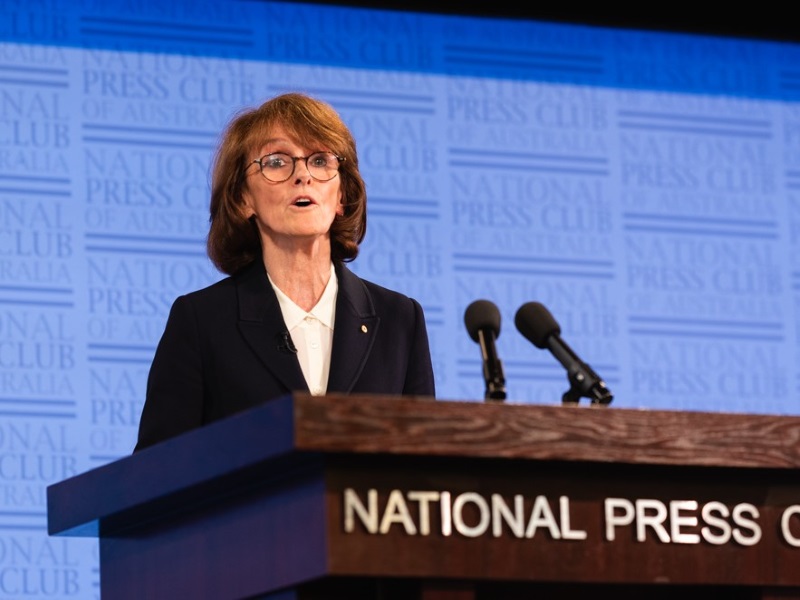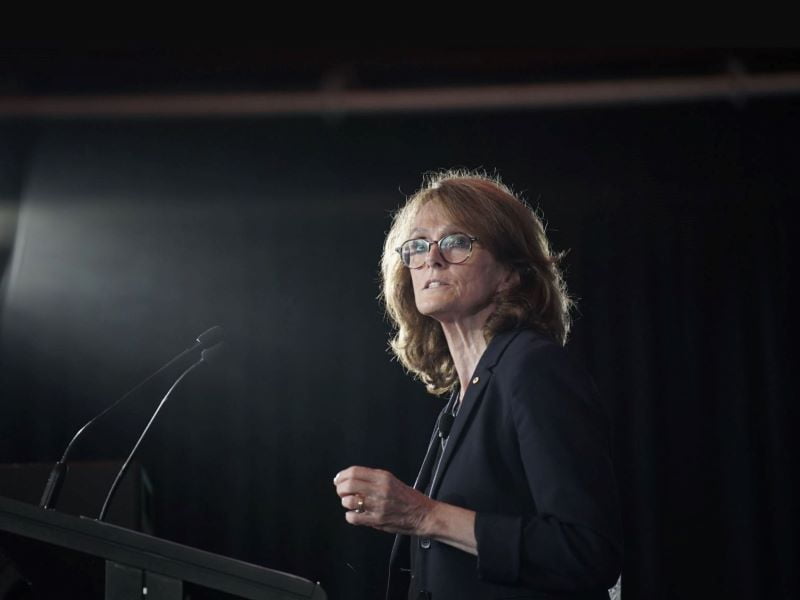Patient policymakers, proactive practitioners and a cultural leap of faith will deliver Australia’s innovation nirvana, outgoing chief scientist Dr Cathy Foley imparted on Monday, as she wraps up four years in the role.
In her final major address as Australia’s chief scientist, Dr Foley implored Australia’s leaders not to shy away from daunting but solvable challenges like plummeting R&D spend, disruptive technologies and the shift to net zero.
But the solutions will also need to come with more patience than governments have historically allowed and a wider cultural shift so all Australians can lean into the global innovation and net zero race.
“We need to be prepared to step up and lead, to question things that we have taken for granted, our ingrained habits, and even the things we think are sacrosanct,” Dr Foley said, according to remarks prepared for her Ralph Slatyer Address in Canberra.
“The contest of ideas is not always a comfortable arena, but it’s where the gold lies.”

Dr Foley was appointed Australia’s ninth chief scientist in 2021 after a successful career at the CSIRO focused on semiconductors and superconducting electronics.
Over four years her focus has been on developing emerging technologies like quantum, unlocking research through open access better metrics and access to infrastructure, and recognising Indigenous knowledge systems.
In an address in Canberra on Monday, Dr Foley laid out progress against her main measures, including Australia’s first plans for quantum and open access, and the recognition of Indigenous knowledge in national priorities and science awards.
Her pioneering work on a national open access system and improving Australia’s research infrastructure network will be passed to the next, yet to be named, chief scientist and the National Science and Technology Council they lead.
“I’ve had the most extraordinary four years,” Dr Foley said at the address named in honour of of Australia’s first Chief Scientist and held during the Cooperative Research Australia’s National Innovation Policy Forum.
“I’ve discovered the enormous convening power of the chief scientist. It’s an extraordinarily privileged position… As chief scientist, I’ve been lucky enough to have the backing of the whole science and research system, the innovation system, the public service and government, all of those people to help me put the pieces together again.
“I’m proud at what we’ve done.”
Dr Foley offered parting advice to the Albanese government as it launches a sweeping review of the national R&D system and tries to kickstart a new era of industry.
She called for patience and a willingness to adapt Australia’s world leading innovation inputs.
“No-one can ever be quite sure what will come from the scientific endeavour,” said Dr Foley, whose work on nitride semiconductors in the early 1980s was foundational to the invention of white-light LEDs 15 years later.
“It’s unpredictable, full of twists and turns, sometimes dead ends, and sometimes sudden advances, and always long in the tooth when you look closely… And yet our history of programs aimed at shifting the dial on complexity, innovation, and entrepreneurialism in the Australia is a history of impatience.”
With some notable exceptions like the Hawke government’s lasting CRC program, innovation initiatives have been abandoned too quickly, Dr Foley said.
The chief scientist was a recipient of the Grants for Industry Research and Development (GIRD) in the 1980s, receiving non-dilutive funding to translate her high-temperature superconductivity research with industry partners.
Dr Foley’s breakthrough had potential in biomedicine and heavy industry but it would be partner BHP’s application of minerals exploration that was fully realised.
The output was LandTEM, a quantum sensor technology used to detect deeply buried ore bodies under cover. It is now in use across Australia, the US and Canada, and estimated to have helped in uncovering $10 billion of ore deposits.
That outcome took years, multiple industry partners and did not always have a clear real world application.
“We might just as easily have ended up back in the CSIRO tearoom drumming up a new idea for superconductivity,” Dr Foley said.
“The GIRD scheme was important to our success, but it lasted just 5 years. The GIRD program was a victim of impatience. What a waste!
“Too often, we set up a program and then expect it to deliver overnight. And yet high-temperature superconductivity, the photonics industry, and the laser industry, to name just a few were all funded by the GIRD program, and only came to fruition 15 years or more after the program was discontinued.”

Dr Foley said the current crop of innovation programs are now at least functioning under a clear pipeline model. The CSIRO On program is encouraging university spinouts, an Australian Economic Accelerator is providing gate funding for proofs of concept and the Industry Growth Program has grants for commercialisation.
At the other end is a landmark $15 billion National Reconstruction Fund to scale up projects and deliver a direct return to taxpayers.
But all need patience and the best returns will come with improvements to wider policy like incentivising business R&D.
“But once the systems are in place, the important thing is to give them time to bed down,” Dr Foley said, “time to iron out the wrinkles, to build awareness and to allow investors and others to feel confident that the supports are in place, and we’ll stay the course.”
Dr Foley isn’t the first to preach patience, but on Monday she said Australia also needs a cultural shift to “belief”.
“I mean it’s one thing to have an ambition. It’s another to believe that the ambition is achievable – and that we’re up to the task,” she said.
Ambitious goals like building the world’s first quantum computer and reshaping a service and resource economy into a clean energy advanced manufacturing one are achievable, Dr Foley said, with a “leap of faith” cultural change.
“Our tendency to resist change has its advantages. We guard our prosperity, our lifestyle, our institutions, and our freedom, well. But it has its disadvantages,” she said.
“It risks stifling creativity and creating vanilla outcomes. It can create a real inertia when it comes to tackling difficult things. I’m not entirely sure where the balance point should sit – but I don’t think we have it right at the moment.
“I don’t think we can truly become the innovative, high-tech manufacturing nation powered by clean energy that we aspire to be until we can imagine ourselves as that nation – and then take a leap into developing technologies that are new to us, or where we’re not sure of the exact outcome.”
Do you know more? Contact James Riley via Email.

